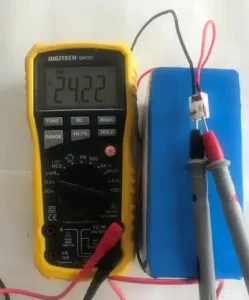Your Robot Lawn Mower Battery – Is It powerful Enough?
It’s not just to do with the brand (although that can play a part). It is also about:
- The physical size of the mower and its mechanical components;
- The number and complexity of electronic components (ie. the circuit boards);
- The sensors, software, and firmware that run on those electronics;
- And then there’s the battery!
How does the battery affect the cost of the mower?

Why choose the one with the better battery?
Large and small, fancy and simple. And we’ve found that there’s one critical component.

Analogy
Why Voltage Matters in Automated Lawn Mowers
- cutting dense grass;
- climbing inclines, and;
- running for extended periods.
Voltage Matters for Performance
The voltage potential of the mower’s battery plays a critical role in its performance. Eg.:
- Motor Power: A higher-voltage battery allows the motor to deliver more power. This is important for mowers working on uneven terrain or cutting thick spongy grass. A low-voltage mower may struggle, or even stall, leading to uneven cuts.
- Runtime Efficiency: Voltage also affects how efficiently the mower uses its battery capacity. While higher voltage means higher energy consumption, it translates to more efficient performance. The mower’s motors can work at their optimal speed, and especially torque, to give them greater cutting power.
- Battery Size and Weight: The lithium battery packs for these mowers are made up of banks of individual cells. These 18650 cells are about the size of an AA cell. If a bank has more cells, it will have higher voltage. It will be bigger in size and weight.

Size matters. What they don’t tell you about how battery packs work.
1. Safety in numbers
Modern lithium-ion batteries are an engineering and mass production marvel. They are made by combining standardised cells. Each cell is small, just a little bit bigger than an AA size battery. Individual cells are about 3.675 Volts (nominal, 4.2 V maximum), and maybe 2.6 Amp hours. And they are packaged to provide safety, because each cell is small enough that damage to a single cell will not create runaway risks for the whole battery pack.

2. Managing the pack
The runaway risks usually occur when the whole combined battery pack is subject to a malfunction, eg. In the regulating Battery Management System (or BMS), which controls the rate and limits of charge delivered to the cells in the pack.
putting cells together in a bank
The following voltages are achieved by wiring a bank of cells together (in series), eg.:
- 3 cells together will deliver 11.1V nominal, or 12.6V max, and 8.4V when ‘run flat’
- 7 cells together will deliver 25.7V nominal, or 29.4V max, and 19.6V when ‘run flat’
As a battery gets used, it uses up voltage, ie. the voltage potential runs down. Note that ‘run flat’ is equivalent to:
- running down the maximum potential by about one third, or
- running down the nominal potential by about one quarter.
And over time, with multiple use, the maximum voltage potential achievable after recharging will gradually become less and less. According to Wikipedia, the 18650 cells are usually rated for around 300 discharge/charge cycles.

putting banks together in a pack
Further to the above each bank can be wired (in parallel) within the pack, to deliver the following for example:
- 2.6 Amp hours from one bank of cells
- 5.2 Amp hours from two banks of cells
- 7.8 Amp hours from three banks of cells
A more powerful battery pack will have more cells, and therefore will cost more to produce. But we show in the following section that it is worth it.

The chemistry of battery cells, banks and packs
The individual 18650 cells have a safe operating voltage range, from 2.7V to 4.2V:
- Above 4.2V is the danger zone. The cell may overheat and risk catching fire.
- Below about 2.5 Volts is the dead zone. A chemical reaction can occur that will permanently damage (kill) the cell.
The BMS is supposed to ensure that these limits are not exceeded, when charging and/or discharging.
Example
Conclusion. Why we prefer to use powerful battery packs, with more cells
- reduce waste, in the event of any battery cell failing;
- extend the life of the battery over its whole life cycle;
- afford the device more power each and every time it runs;
- help ensure a more reliable and maintenance free experience overall.

